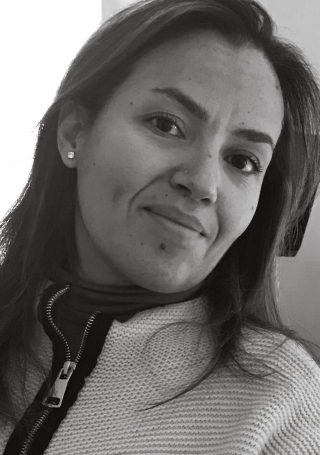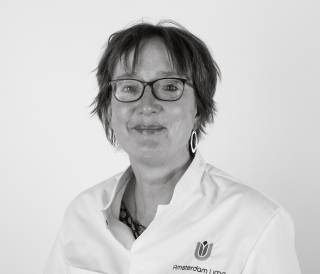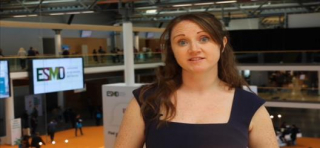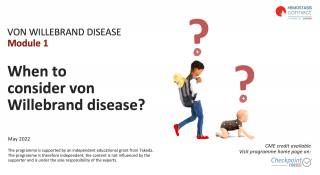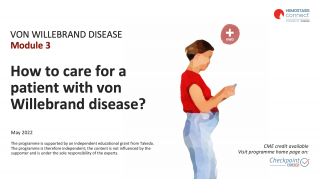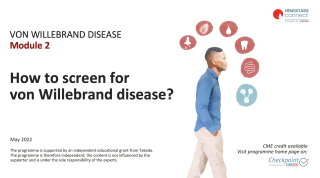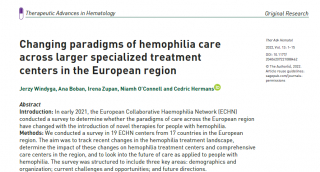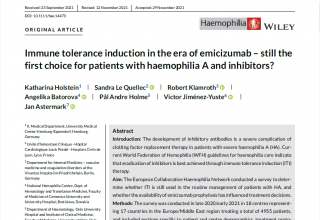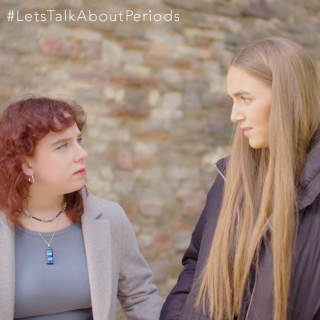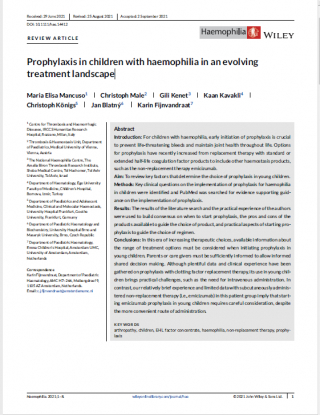
Podcast on prophylaxis in children with haemophilia
Podcast on prophylaxis in children with haemophilia
Prof. Karin Fijnvandraat and Dr. Maria Elisa Mancuso discuss their views on prophylaxis in children with haemophilia. Prof. Karin Fijnvandraat and Dr. Maria Elisa Mancuso discuss their views on prophylaxis in children with haemophilia.Dr. Maria Elisa Mancuso, Prof. Karin Fijnvandraat
As authors of a recent European Collaborative Haemophilia Network white paper, published in Haemophilia, Prof. Fijnvandraat and Dr. Mancuso share their views on the many treatment decisions involved in prophylaxis in children.
Podcast |
30 min
|
Mar 2022
This programme was made for you: your opinion matters
Share your feedback in just 4 clicks and help us to continue to create the content you need.
I agree that this educational programme:
Please note:
HEMOSTASIS podcasts are designed to be heard. If you are able, we encourage you to listen to the audio, which includes emotion and emphasis that cannot be grasped from the words on the page. Transcripts are edited for readability. Please check the corresponding audio before quoting in print.
HEMOSTASIS CONNECT is an initiative of COR2ED supported by an educational grant from Takeda. The views in this podcast are the personal opinions of the experts. They do not necessarily represent the views of the experts' academic institution or the rest of the HEMOSTASIS CONNECT group. For experts' disclosures on conflict of interest, please go to Hemostasis on the COR2ED website.
Prof. Karin Fijnvandraat
Hello and welcome to this podcast! My name is Karin Fijnvandraat. I'm a paediatric haematologist and head of the Haemophilia Treatment Centre in Amsterdam.
Dr. Maria Elisa Mancuso
Good day, everyone. I am Maria Elisa Mancuso. I am a haematologist working with bleeding disorders in Milan, Italy.
Today, Karin and I will discuss prophylaxis in children with haemophilia in this evolving treatment landscape. We know that currently the treatment landscape for haemophilia is pretty exciting. We are both authors on a white paper on this topic that was recently published in Haemophilia journal. It was developed within a group, a collaborative group, which is called the European Collaborative Haemophilia Network, together with our colleagues, Christoph Male, Gili Kenet, Kaan Kavakli, Christoph Königs and Jan Blatný.
In the paper, we tried to build consensus around the topic of prophylaxis in children with haemophilia. And I really look forward to discussing some of the key topics in this podcast.
So, Karin, when we talk about prophylaxis in children with haemophilia, the first question indeed is: when do you start prophylaxis?
Karin Fijnvandraat
I think prophylaxis should be started as early as possible in order to prevent the two major bleeds that we are afraid of in patients with haemophilia: intracranial bleeding and joint bleeding. Therefore, in our consensus, we recommended starting primary prophylaxis as soon as possible, ideally before the occurrence of any joint bleeds and definitely no later than two years of age. Because the first joint bleed occurs at a median age of 18 months, and the risk of intracranial bleeding is quite high in neonates, it's about 2 per 100 births.
So, Maria Elisa, we discussed when to start, but now the question is: what product do you start with once you decide to start prophylaxis? Do you choose replacement or non-replacement therapy? There's a lot of considerations that can be taken into account for this decision, and I would like to ask you, what is your idea about this? What are your considerations that come to your mind when you are in your clinic in Milano discussing this?
Maria Elisa Mancuso
You know, I think that when we start a discussion with parents -- because we are talking about children, so the discussion is mainly done with family -- I think we should address some crucial points. First of all, I think it's also your experience that parents want to know how effective is the therapy that you are going to do, how safe it is for the child. And everything also passed through very practical considerations. Because when we started having children with haemophilia, we enter their lives. So we are starting something that has an impact on daily life. So we also have to take into account the burden that we are giving to the family and to the child. If we think about efficacy, so far, we can say that both the replacement and non-replacement therapy are effective in bleeding prevention.
Karin Fijnvandraat
Yeah, definitely.
Maria Elisa Mancuso
So, the consideration is again, what you already mentioned… If we think about a newborn and we have, let's say, the fear of intracranial haemorrhage, starting very early could be a game changer. However, if we think about replacement therapy in a practical way, we should address the issue of frequent venous access, which is not easy in a very young child. So the subcutaneous route of administration of the non-replacement therapy can be a way to overcome such an obstacle.
On the other side, you mentioned that the other goal is to prevent joint bleeds. We can do it with both therapy approaches. But still, we have less knowledge about the long-term joint outcome with no replacement therapy. We had, let’s say, decades of experience with replacement therapy, but we are still learning how good long-term prophylaxis with non-replacement therapy can be for the joint outcome.
Karin Fijnvandaat
Yeah, I think this is a very important point about the lack of experience. And, as you mentioned in the beginning, for parents it's a really difficult decision to make, and it's very important also for them to make a decision that feels safe for them.
Maria Elisa Mancuso
Okay, you touched the other point: safety. So after you explain to them how effective you can be with your prophylaxis, either with replacement or non-replacement, the other point is safety: how safe we are with these long-term treatments. We have to explain to them that as soon as we start exposing the child to factor VII, we enter the period of risk for inhibitor development. And they should know this risk is there, at least for the first 20 to 50 exposure days. But if the child becomes tolerant to factor VIII, so he does not develop any inhibitor, then the risk is very low.
On the other side, of course, if we do not expose by using straightforward non-replacement therapy, maybe we can delay this moment of risk of inhibitor development. We have to always remind them that we cannot control an acute bleed, let's say a post-traumatic bleed, with non-replacement therapy. So sooner or later the child will use some factor VIII. And the issue of inhibitor development should be explained to parents, because I think that the only safety concern for children with haemophilia is the exposure to factor VIII and the risk of inhibitor development.
On the other side, we can say that through factor VIII, we can in re-induce tolerance. So we also have to explain that even if the child develops an inhibitor he can be treated for prevention with non-replacement therapy. But at the same time we can restore tolerance to factor VIII using immune tolerance induction. So, there are several points I think that we should address discussing with the family, explaining the pros and cons, considering that for very young children the subcutaneous route of administration in some cases is a very practical consideration that has very great impact on everyday life of the child and family.
Karin Fijnvandraat
So, Maria Elisa, don't you think that the information that we have to give to the parents, like all the points that you now explained, it's a really very large volume of information and also quite complicated. So, it's a really asks for more time to sit with the parents repeatedly and really be sure that they understand all the aspects.
Maria Elisa Mancuso
I think it's crucial to give them time, also to ask questions, to go back and forth on the topics. Of course, it's very different if you are talking to parents with a family history of haemophilia or a new couple who never heard about the disease. So it's very complicated, but I think it's doable if you engage them on a path, giving them the opportunity to understand that they are not alone, that you will accompany them, step by step.
Karin Fijnvandraat
Yeah, that's the picture that comes to my mind: we walk the path together and we have the same destination, we and the parents. And the same destination is, of course, the health of the child, and their future health. But the ways to reach these goals can be different. In Dutch we have this expression: there is more than one road leading to Rome. I don't know if you have that expression?
Maria Elisa Mancuso
Yes, we have it also in Italian, but in Italian it is: all the roads lead to Rome.
Anyhow, let's explore that route of replacement therapy. When do you use this in your patients and how do you decide between the plasma-derived and recombinant products? Because when we say replacement, this word includes multiple choices, especially considering the source of factor VIII, so coming from plasma donation or recombinant technology.
Karin Fijnvandraat
We already discussed how important it is to do a shared decision-making process about factor replacement or non-replacement therapy. Of course, if the parents choose factor replacement, then they should be aware that there are two classes: the plasma derived or the recombinant. This is also something that was historically well known but present parents may not be aware of the plasma-derived factor products so much, because recombinant treatments have now become a mainstay in the treatment for many diseases. And when we consider the choice between plasma-derived or recombinant, one of the issues to take into account is the inhibitor risk. There was an important trial, I think you participated in it Maria Elisa, the SIPPET trial, that demonstrated that the inhibitor risk in plasma-derived clotting factor concentrate is reduced compared to recombinant. And once this trial was published, a huge discussion took place, and this discussion is still going on, whether the results of this trial can be extrapolated to any other patient group. When I discuss it with parents, I mention the SIPPET trial and I try to put it into perspective as well as I can. And in that way, I make parents aware of the academic continuing discussion about a reduced inhibitor risk in plasma derived and that it may be an advantage.
Maria Elisa Mancuso
But also, there is the consideration also that the SIPPET trial was done in the period where a lot of new molecules that nowadays we can use in children were not available. So it's not easy. You know, it's a piece of knowledge that we have to use when we address the risk of inhibitor development, but also we have to take into account that really the treatment landscape is very rapidly evolving. If we look at some studies done 10 years ago, they can already be a little bit old considering the new possibilities that we have nowadays. So I agree with you, we have to include this consideration, but also put it in perspective.
Karin Fijnvandraat
Yeah, I agree completely. And also regarding the plasma-derived factor, of course, there has in the past been a very tragic period, it's almost 40 years ago now, with the transmission of viral infections. And of course, the present-day plasma-factor products are much more safe and the donors are screened. But still, it's a theoretical risk that should be discussed with the parents. And in my opinion, there is heterogeneity in the choice that parents make. Some prefer a recombinant and others plasma derived. So I can see you smiling, so you agree. Of course, in the podcast you cannot hear the smile, that's why I mention it. And you smile even more now. Never mind. The next question is: if you choose recombinant, there's still a choice. There's so many choices. There's still a choice to be made between standard half-life and extended half-life. How do you discuss that and what are your considerations in that respect?
Maria Elisa Mancuso
You know Karin, if I just look back at my period in haemophilia and I think about 10 years ago, who would have ever thought about the multiple choices that we have today? I mean, for years, we just had some recombinant, pretty much similar one to the other, and then some plasma derived. Nowadays, we have a big step forward that was brought by the extended half-life. You know, knowing the burden related to the regular intravenous injection, the first step was to adapt prophylaxis to ever patient’s life. This was indeed possible with extended half-life because if we do less injections, you have also better adherence. Of course, in children you rely on parents’ adherence, which is this 100% in my experience. Anyhow, having the opportunity to do less venepunctures or also reduce the chance to have central catheters and so on.
Here I think it's good to do a distinction between haemophilia A and haemophilia B. For factor IX, we know that the extended half-life products are so prolonged in their persistence in the bloodstream. We have a prolongation of half-life of about four to five folds the wildtype that indeed, for me, there is no room anymore to use a standard factor IX. Because we can provide the prophylaxis with a once weekly or once every 10 days injection. I think that this is something really valuable.
Karin Fijnvandraat
Yeah, it's amazing. These products have half-lives between 70 and 90 hours or even longer. So this is a real advancement. So maybe you can explain why is it that in factor VIII prophylaxis or products, the extended half-lives are limited? Why don't they reach 70 to 90 hours?
Maria Elisa Mancuso
This is related to the nature of the molecule. You know that factor VIII needs to couple with von Willebrand factor when it is injected. Even if we have technology prolonging the half-life of factor VIII, this doesn't overcome the time cap posed by the half-life of von Willebrand factor. This is not the case with factor IX. Factor IX has no carrier in the plasma, so you can somehow modify the PK profile with a little bit more freedom. So this is the main difference.
If we go back to haemophilia A, indeed nowadays we have some extended half-life products, but unfortunately due to regulatory reasons we currently have only one extended half-life product that we can use in children younger than 12 years.
For me, another consideration: if we consider the response to factor VIII of children with haemophilia, there is a very huge interpatient variability in the response, related to PK, so to pharmacokinetics. So that's why, in our consensus, for children with haemophilia A younger than 12 years, we consider the choice of a product to be individually tailored. So look at the bleeding frequency, the characteristics of the child and also the pharmacokinetic parameter. Because we can come up with a good response and a very good choice also for a standard half-life, considering that the chance to have extended off life at the moment for children is limited only to one product. But we know that on the horizon we will have new products for the future. But for haemophilia B I would say that the answer is: when possible, when available, extended half-life is the first choice.
Karin Fijnvandraat
Yeah, I agree completely with you. There's no issue in not choosing EHL in haemophilia B, because these half-lives are so long 70 to 90 hours, it's really much more convenient. And unfortunately…
Maria Elisa Mancuso
Yeah, I wanted to ask if you can give us some... How do you decide on the regimen? Because, okay, you decide the product, but what about how to use?
Karin Fijnvandraat
There's also been historical changes, whereas previously a threshold of 1 was acceptable, 1% threshold level, and now the WFH has recommended that we make our regimen in such a way that we achieve a threshold of 3 to 5 units per decilitre. And this recommendation was only possible because EHL came into play. In standard half-life products, if you would aim for a threshold of 3 to 5 units per decilitre, this would imply such an intensive regimen, that it's just not doable. So this is really what we're aiming for now.
And you already mentioned the issue of venous access, which can be quite challenging in young babies. Therefore, in our hospital, we build up the prophylaxis regimen. So we start with once weekly and when we see that a bleeding phenotype asks for it, we increase it to 2 or 3 times weekly in haemophilia A.
Maria Elisa Mancuso
Maybe this is also good because the child gets used to the practise of venepuncture. Usually, we escalate quite quickly. I think we also agreed that as soon as you can start with the standard regimen, the better it is for the child. But, I agree, you can start once weekly. Also, because the family gets used to it, the child gets used to the practise. And this makes all the process a little bit smoother.
Karin Fijnvandraat
So we agree that, of course, we have to prevent joint bleedings and at the same time we have to smooth in the prophylactic regimen. And I think this is really true paediatrics. How to coach the family? Our nurses are very good at this, you know, training the families and building their confidence. This is an aspect that should not be underestimated. And of course, we are used as professionals to children with haemophilia. But for a family, it’s their precious child and this terrible disease. And it's a lot of psychosocial support and confidence building and coaching.
Maria Elisa Mancuso
I totally agree with you. This is very important.
I will ask you: if you go to non-replacement therapy, what do you take into account when you decide to start with emicizumab prophylaxis or non-replacement?
Karin Fijnvandraat
This is another complicated question with many aspects. Regarding the non-replacement therapy it's very important to realise that these are only used for prophylaxis, not for the treatment of bleeds. And there are several non-replacements in the development phase, like antibodies against TFPI and siRNA against antithrombin. The only approved non replacement therapy presently is emicizumab. And this has been used quite a lot worldwide over the last few years. But the data that have been published in very young children is still limited. And there's a number of important questions about prophylaxis in young children. And one of the important questions is what does this mean for tolerance towards factor VIII? Because these children use emicizumb for prophylaxis, but as you explained earlier, so eloquently Maria Elisa, when they have a bleeding they still need factor VIII to stop the bleeding. And it will take a much longer time to have 50 exposure days if you're on emicizumab than if you're on factor VIII prophylaxis. And why do I mention the 50 exposure days? Because that is sort of the moment in time where we decide if someone has developed an inhibitor or not. Usually, the inhibitors are developed much more early. The median is about 9 to 11 exposure days, but at 50 exposure days when you then have not yet developed an inhibitor, we say: okay, you’re tolerant. And this could take years, maybe 10 years. Nobody knows. So this is one of our big questions: what will prophylaxis with emicizumab mean for tolerance? Will there be a higher proportion of patients who are tolerant or a lower proportion? Nobody knows. You already mentioned that this knowledge gap should also be discussed with the parents. We also discussed this in our group. We agreed that's if new-borns or very young children are started with emicizumab, it should ideally be done in the setting of a clinical trial or a well-managed registry, to allow collection of data on safety and efficacy in this patient group.
Maria Elisa Mancuso
I think this is a very important point. I mean, if data are limited, the only way that we can learn how to do, is collaborative experience. Because we know that the disease is rare. It's not easy to have data on very young children also, because, as we mentioned before, the median age of diagnosis is around 12 to 18 months. So if we think the use of a new drug in newborns… I mean, how many newborns do we diagnose with haemophilia that early? Not so many. So I think that the suggestion to do our experience in a joint effort, in a collaborative group, building up studies, building up a registry, is something very valuable
Karin Fijnvandraat
I couldn't agree more with you, Maria Elisa. This is exactly what is our responsibility also to these vulnerable children, their parents and the scientific community.
To get back to inhibitor development, regarding the choice for clotting factor concentrate or non-replacement therapy: what role do you think the risk of inhibitor development should play in these decisions?
Maria Elisa Mancuso
You know, Karin, I think you mentioned a very crucial point, and I totally agree with you. Let's say, we have to disclose what we know and what we still don't know. Because at the moment, we have no solution for the unknowns. We have to learn. I have to say that, of course, parents should be aware of the risks and the different scenarios. If you do a diagnosis because a child is born in a family with a family history, you can take your time to explain everything because maybe this child is healthy, he's not bleeding. So, you have the time to let the parents understand the choices and the pros and cons. Sometimes you do you have not the time because you make your diagnosis because the child is bleeding already. And if the child is bleeding, you have to expose him to factor VIII, so the exposure is already there. And as soon you start exposing, you enter the risk period in terms of inhibitor development. So there the situation changes immediately because you have to explain to the parents that we started exposing him, we started somehow stimulating possibly the immune response. So again, the path is different. We can either decide to stop any new exposure, maybe go for non-replacement, but knowing that at each new exposure in the future, the risk is still there. Or the other way could be that we continue to expose them regularly in the absence of bleeding as prophylaxis, maybe completing the 50 exposure day risk period. Because we know, as you beautifully mentioned, that if we pass uneventfully this period, we know that the risk then is very, very low. And any other choice even going to non-replacement therapy, I think it will be taken with a different perspective, also emotionally. Bcause the risk is very different and each new exposure has a different meaning, a different weight in the life of the child.
Karin Fijnvandraat
That's very well said Maria Elisa. Thank you very much for a great discussion today.
What I take away from it is that we are both dedicated paediatricians, driven to provide individually tailored therapy. And that every child and every family is different and has other needs that we try to meet. And also, it's so important to do shared decision making with parents. And in this shared decision, there's an important role for us to make them aware of the knowns and the unknowns about the current new therapies. And well, when we discussed it, I was really impressed by all that pops up on the horizon for even newer treatments that are presently under development. And your call for collaboration to collect safety and efficacy data in very young children using all these new treatments. I think we should take that, and I personally take it very serious.
Maria Elisa Mancuso
Yeah, me too. And I totally agree. I do think that the other point is that we always have to give parents and patients and families the good time to discuss. Understand if they understand well what we are trying to explain to them. Then we will have the best outcome, because they will accept, they will be motivated, and we will also be able to maintain some unknowns without, let's say, the pressure of doing something which is not good. So, I do think that treatment individualisation should be our aim for each new patient that we meet, with the hope that the future will give us and them many, many, many new opportunities. So I thank you, Karin. It was really a pleasure.
Karin Fijnvandraat
Yeah, thank you.
We walk the path together with our patients. All the roads lead to Rome.
Maria Elisa Mancuso
Tutte le strade portano a Roma.
Karin Fijnvandraat
I think that's a nice philosophy to end our podcast, there are many ways that our aims can be achieved together.
Maria Elisa Mancuso
Yes. Thank you, Karen.
Karin Fijnvandraat
Thank you
In this podcast episode the two experts discuss when they start prophylaxis in young children, how they choose between plasma-derived and recombinant products and how they select the right treatment regimen, as well as practical aspects of starting prophylaxis, including the importance of involving parents in the decision-making process.
This HEMOSTASIS CONNECT podcast is also available on Castos, Spotify, Apple Podcasts and Google Podcasts
HEMOSTASIS CONNECT is an initiative of COR2ED, supported by an Independent Educational Grant from Takeda.





